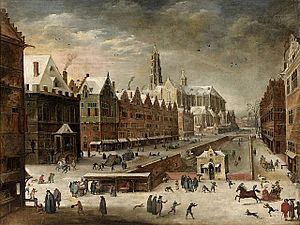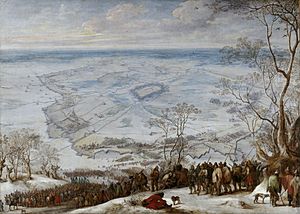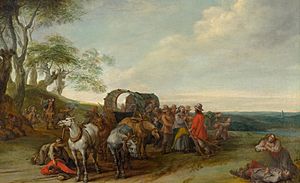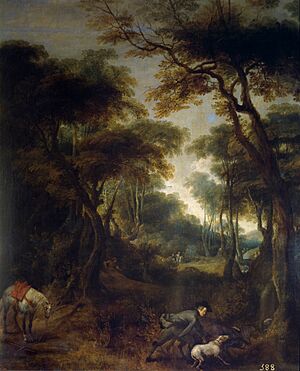Peter Snayers facts for kids
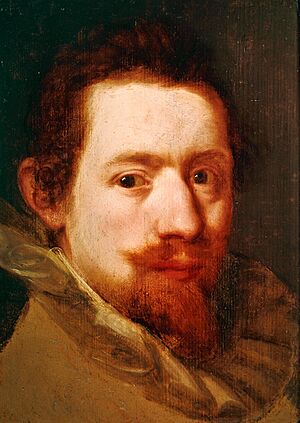
Peter Snayers (1592–1667) was a famous Flemish painter. He was best known for his large paintings of battles. He also painted scenes of cavalry fights, attacks on villages, and hunting scenes. Snayers became famous for his battle paintings that showed the battlefield from a high, "bird's-eye" view. He also painted big landscapes and portraits of important people. He often worked with other painters, including the famous Peter Paul Rubens.
Snayers started his painting career in Antwerp. Later, he moved to Brussels, where he worked for the royal court. He became the main artist for military scenes at the court. He was even given the title of court painter and a military rank.
Contents
Life of Peter Snayers
Snayers was born in Antwerp, a city in what is now Belgium. He was baptized on November 24, 1592. His father, Lodewijk, was a city messenger. In 1612, Snayers became a student of Sebastiaen Vrancx in Antwerp's Guild of St. Luke. Vrancx was a well-known painter of battles and everyday life. By 1613, Snayers had become a master painter in the Guild.
In 1618, Snayers married Anna Schut. She was a cousin of the painter Cornelis Schut. Their first child, Cornelis, was born in 1620. Snayers became a very successful artist. In Antwerp, his family lived a rich lifestyle. He even took part in fancy banquets held by a local club called Violieren.
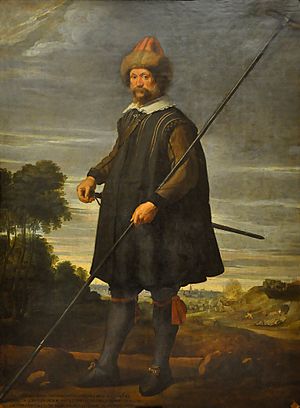
Snayers joined the painters' guild in Brussels on June 16, 1628. He also became a citizen of Brussels around this time. It is thought that he had already been working for Albert VII, Archduke of Austria (who died in 1621) while still living in Antwerp. He was named a court painter by the Archduke. Snayers likely moved to Brussels to find more opportunities at the court. This was the court of Isabella Clara Eugenia, who was the Archduke's widow and the ruler of the Southern Netherlands.
After Isabella died in 1633, Snayers continued as court painter for the next two rulers. These were Cardinal-Infante Ferdinand of Austria and Archduke Leopold Wilhelm of Austria. For them, he painted scenes of famous battle victories. He also painted portraits of important people in Brussels and large landscapes. He received a special order for 22 battle paintings from General Ottavio Piccolomini.
Even while working in Brussels, Snayers often visited Antwerp. However, he never moved back there. He worked with painters in Antwerp, like Peter Paul Rubens, on several projects. These included a series of paintings about the Life of Henry IV and the Torre de la Parada series. Snayers was part of the high society of his time. He became more and more successful and lived a life similar to the rich people of his day.
Some of Snayers' students included Guilliam van Schoor and Adam Frans van der Meulen. Adam Frans van der Meulen later became a leading battle painter for King Louis XIV of France.
The exact date of Snayers' death is not known. However, it is believed he died in Brussels in 1667.
Snayers' Artworks
What Snayers Painted
Peter Snayers is mostly known for his paintings of battles and military events. He also painted scenes of villages being raided and attacks on travelers or convoys. Besides these, he created portraits of important people in Brussels and big landscapes. He also painted several hunting scenes and a few religious pictures. Sometimes, he painted public parades of guilds and local militias.
His painting style used colors that were a bit softer than his teacher Vrancx. This style was common in Flemish and Dutch art of that time.
Painting War Scenes
Peter Snayers created large historical battle scenes. He also painted smaller works showing cavalry fights and soldiers resting. His historical battle scenes were very detailed and showed the places accurately. Often, these paintings showed a town under attack from a bird's-eye perspective. Snayers made sure his battle scenes looked as real and complete as possible.
He was not actually present at the battles he painted. To make his paintings look so real, Snayers used official military maps and war reports. He also used ideas from other artists. He looked at prints by artists like Georg Braun and Jacques Callot.
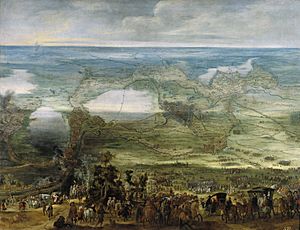
Snayers usually did not add signs or labels to his paintings to explain which battle was shown. This made the pictures look more realistic. However, it also meant that viewers needed to already know about the battle to understand the painting. Most of his works were ordered by high-ranking military leaders. These leaders would have known the scenes very well.
His large paintings had two main purposes. They recorded historical events. At the same time, they honored the military leaders who fought in those battles. The paintings were made from the point of view of the person who ordered them. They often included portraits of the leaders on horseback and their family symbols. This helped to remember their military achievements. These heroic images were also meant to be an example for future generations.
Snayers also often painted scenes of robbers attacking travelers. He also painted soldiers plundering villages. These topics were similar to his military scenes. One example is the Flemish landscape with travellers attacked by robbers. This painting shows travelers in a coach trying to fight off robbers. The scene is full of action, showing different parts of the attack.
Working with Other Artists
It was common for artists in the 1600s to work together. Snayers often collaborated with other painters. He regularly worked with landscape painters like Joos de Momper, Jan Brueghel the Younger, and Alexander Keirincx. He also worked with Peter Paul Rubens.
When Snayers worked with landscape painters, he would paint the people in the scene. The other artist would paint the landscapes or cityscapes. He worked with Joos de Momper mostly between 1613 and 1620. His collaborations with Jan Brueghel the Younger happened after 1634. An example of his work with Joos de Momper is the View of a city canal in winter with figures, presumably in Antwerp. This painting shows a snowy city street and canal. Many people are shown doing their daily activities. Children are playing, and merchants are busy at their stalls. This painting shows what life was like in a 17th-century city in Flanders. The city shown might be Antwerp.
Snayers also worked with Peter Paul Rubens on two big projects. One was the unfinished series about the Life of Henry IV (1628–30). The other was the Torre de la Parada series (around 1637–1640). The Life of Henry IV series was ordered by Marie de' Medici, the Queen of France. It was meant to decorate her new palace in Paris. Rubens started working on 16 battle paintings for this series. Snayers painted the upper parts of these paintings, which showed detailed battle scenes. These small, detailed figures were different from Rubens' larger figures in the lower part of the paintings. Even with these differences, the paintings looked like one complete work.
The Torre de la Parada was a hunting lodge for the Spanish king near Madrid. King Philip IV of Spain asked Rubens to create many paintings to decorate it. Most of these paintings showed stories from Greek myths. Rubens worked with many other Antwerp painters on this project, and Snayers was one of them. Two large paintings showing King Philip IV hunting are believed to be by Snayers.
See also
 In Spanish: Peter Snayers para niños
In Spanish: Peter Snayers para niños


